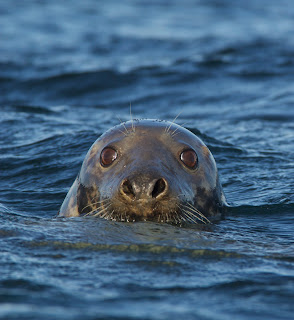Recently I was a guest presenter on BBC 2’S Autumnwatch, tracking down the secret seals of the South East. This population of grey and common seals, ranging from the Thames Estuary down to the Straights of Dover, has probably been around for a very, very long time, but the problem is, no one really knows. Unlike seals up in Scotland and along the Norfolk coast, these seals are pretty much unstudied. Hence the tag “secret seals”.
 I flew out to the treacherous Goodwin Sands, tidal sand banks in the middle of the English Channel to try and find the animals. Sure enough, there they were, bobbing about with huge container ships and off-shore wind turbines swinging around in the back ground, and it’s the wind turbines that got me onto the subject of accidental nature with my seal expert John Bramley from the Kent Mammal Group.
I flew out to the treacherous Goodwin Sands, tidal sand banks in the middle of the English Channel to try and find the animals. Sure enough, there they were, bobbing about with huge container ships and off-shore wind turbines swinging around in the back ground, and it’s the wind turbines that got me onto the subject of accidental nature with my seal expert John Bramley from the Kent Mammal Group.A recent blog post looked at how a migrating Osprey has been helped by an offshore wind farm providing a roosting spot. Now, John has suggested to me that seals may be benefiting too. And there are two ways in which the wind farms are creating a cool bit of accidental nature.
Firstly the giant poles, which are driven into the seabed, are probably beginning to create lots of small reef systems around their bases on the seabed. Much like sunken ships do. This will be a more productive habitat for small marine life, which will in turn be better for bigger marine life, like fish, which are food for seals. More fish may mean more seals. A good start. Secondly, the wind farms have effectively created no-take zones. Fishing boats are not allowed in and around the wind turbines. It’s too dangerous. So, suddenly by complete accident we have a few square miles of protected marine habitat where there was none. So, all those potential extra fish benefiting from the new reefs are then protected.
We know from the only English no take zone in existence around Lundy Island that productivity increases markedly both in and around no-take-zones. So, it’s not unreasonable to think John is right about this. Because no one has studied the seals in the long term its hard to see if there has been an effect of this potential increased food supply, but local boatmen suggested to me that they think numbers are on the up. Far from a planned result of offshore wind farms, but good to my mind.
The seals out on the Goodwin’s were largely grey seals. I went to look at Common Seals at a small estuary called Pegwell Bay on the mainland Kent Coast. These seals success has a much more defined link to we humans.
Pegwell Bay where they live is a nature reserve. It’s protected as a European Special Area of Conservation. Strange, as either side of the bay, the coast, despite having potential to be a wonderful wildlife habitat, has been built upon left right and center. Why was this estuary saved from that fate? The answer lies in that during World War One the estuary was owned by the Ministry of Defence. They made a port along the river; it was a major staging post for Royal Navy ships and for transporting troops to Europe. After the war the base was decommissioned but remained MOD property. Because of that, it was never built on, and nature reclaimed the site and it became an oasis of green amongst a rather grey coast. A case of accidental nature if ever there was one. The seals are certainly benefitting from it today as their numbers seem to be increasing, and there are even reports of them breeding there.
I guess after my films on Autumnwatch go out the secrets seals of the South East will be a little less secret in one sense. But in another there still very much a mystery. We have so much to learn about them that they are still certainly still surrounded by questions. For instance, no one even knows how many seals live here in this part of the world.
I love the idea that some of Britain’s largest and most charismatic animals are living in the South East, I hope some happy moments of accidental nature can help it stay that way.






